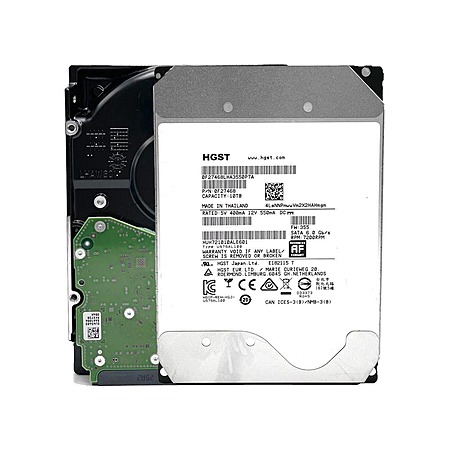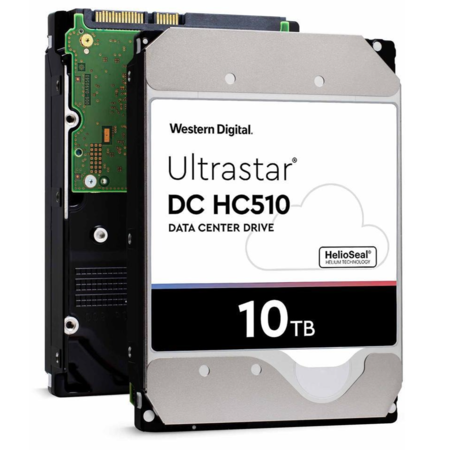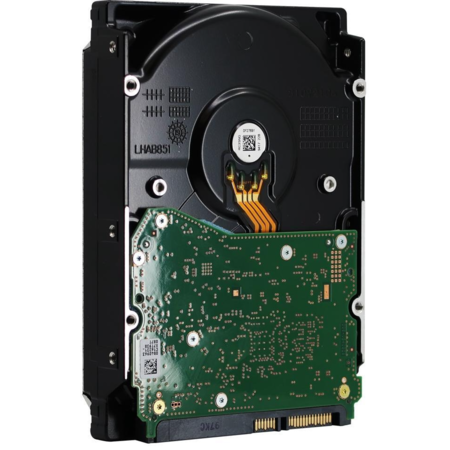expiredsr71 posted Feb 15, 2024 08:20 AM
Item 1 of 3
Item 1 of 3
expiredsr71 posted Feb 15, 2024 08:20 AM
10TB HGST WD Ultrastar DC HC510 3.5" SATA 7200RPM Hard Drive (Refurb)
+ Free Shipping$80
$90
11% offNewegg
Visit NeweggGood Deal
Bad Deal
Save
Share






Leave a Comment
Top Comments
https://www.newegg.com/p/1Z4-001J-00E07
Western Digital's failure rates are astoundingly low.
https://www.backblaze.c
117 Comments
Sign up for a Slickdeals account to remove this ad.
Our community has rated this post as helpful. If you agree, why not thank phillymozart
2 redundant drives in every array with the standard 3-2-1 backup method is plenty in case of emergency.
Most mfrs don't actually refurbish most of the things they sell. Dell, HP, and Lenovo basically reformat their stuff, slap a sticker on it, and ship it out again. Which is fine if the price is right. Same applies here.
If you're not in the market for used gear, just move along. No reason to make up reasons and try to scare people away.
More impressed if you've been doing this for 30 yrs, but they you are likely lying.
All HDDs fail. Eventually. Period.
I buy used enterprise drives because I've been burned too many times by "blue" and less drives far too many times. Basically, the warranty ends and within 3 months, they die.
Give me a used, proven, enterprise HDD.
Drive failures tend to happen at specific points in the life of the HDD for enterprise drives. They fail in the first year if there's a design or manufacturing issue.
They fail in the first 4-5 yrs of the components are substandard or the environment is hot or has vibrations.
Enterprise drives should pass those 2 check points easily. Any new HDD that has a 5 yr warranty is basically the manufacturers stamp that they believe it is well designed, well engineered, and made well. NAS drives get a 3 yr warrant for a reason. "Blue" HDDs are equiv to white label drives. Green are the Blues that had to be slowed down to work. They are drives that failed testing somewhere.
At least that's my take.
In my small sample of enterprise storage at home, less than 50 devices over the decades, the "enterprise" drives have lasted well over 10 yrs before even starting to show *any* issues in the SMART data, which usually means just a few reallocated sectors.
Regardless, backups are a way of life. If I can't backup the data, I don't want to have it. RAID is never a replacement for backups. Sometimes when a RAID array fails, the only solution is to restore the data from backups.
10G doesn't work for my storage needs - it buy in 4TB multiples - so those 12TB HDDs are more interesting to me.
Also, I've bought used enterprise HDDs from this vendor before. Lat time was 4 drives. On arrival, I ran a long SMART test and found some reallocated sectors on 2 of them. Returned for replacement and those came back without any issues. They are still in use here. No problems. I think it is about 3 yrs with the new-to-me, used, HDDs:
The recommended minimum for backing up data you care about is what's referred to as a 3-2-1 backup. The "3" in there refers to having your data on 3 separate drives/arrays.
If you'd like to reduce downtime and avoid losing new data before it is backed up, then you also want to include some type of RAID. This is highly unnecessary for most home users. But it is something enthusiasts like to use as well.
After all of this, you might end up with 4+ drives to hold your data and back it up.
I also work in the IT world, these refurb drives work great. I've had one at home for 7 years runing 24x7 with zero issues.
Your odds are wrong. MTBF for enterprise drives is considerably higher than consumer drives.
Sign up for a Slickdeals account to remove this ad.
Most mfrs don't actually refurbish most of the things they sell. Dell, HP, and Lenovo basically reformat their stuff, slap a sticker on it, and ship it out again. Which is fine if the price is right. Same applies here.
If you're not in the market for used gear, just move along. No reason to make up reasons and try to scare people away.
I'm not in the market for used hard drives, but these posts are labeling the drives as "refurbished", in the 12TB thread there were actually people thinking they will open up the drive and refill the Helium. So a lot of people don't get that these are USED hard drives, there's no actual refurbishment going on other than wiping the data and maybe the SMART data. So it's not scaring people away, it's letting them know exactly what they are buying. If SD puts a warning on all thee posts, then I won't need to post this.
I also work in the IT world, these refurb drives work great. I've had one at home for 7 years runing 24x7 with zero issues.
Your odds are wrong. MTBF for enterprise drives is considerably higher than consumer drives.
Also, you call me out ("Your odds are wrong"), and then proceed to not back up your statement with any relevant evidence. I'm happy to admit I'm wrong. But nowhere in my post did I mention consumer drives. All I did was compare "new" vs "old". Since I didn't mention consumer drives, the most logical conclusion would be that I'm comparing the drive in the post to a similar one that is brand new.
What you could have argued would be something along the lines of how a lot of drives fail soon after they are first used. There may be statistics showing a person is better off getting a working used drive over one new in box. I'm not sure. But that goes down a more complicated rabbit hole of scanning and breaking in hard drives.
I was also giving new drives the benefit of the doubt since my argument was against them. The purpose was to show that even if a brand new drive was more reliable, you may be better off spending money on multiple used drives instead. Because once again, the overall goal of my post was to respond to "I don't get why anyone would buy a refurb drive."
I'm not in the market for used hard drives, but these posts are labeling the drives as "refurbished", in the 12TB thread there were actually people thinking they will open up the drive and refill the Helium. So a lot of people don't get that these are USED hard drives, there's no actual refurbishment going on other than wiping the data and maybe the SMART data. So it's not scaring people away, it's letting them know exactly what they are buying. If SD puts a warning on all thee posts, then I won't need to post this.
I have several and smart helium level never budges, so either it's stable or it's wrong. Either case there doesnt seem to be any studies on this so the warning is based on nothing.
if you're considering in buying, these are heavily used with lot of hours and "miles" on them. Servers are on 24/7 with no chance of sleep and likely heavy traffic. buy them for a redundant raid setup, not just one single drive. be aware that Warranty is from seller only and not manufacture.
I still am pondering on getting one maybe two for my setup at home.
Since the drive comes without any enclosure and cables, I'd have to buy an external HDD enclosure for 3.5 inch drives. Does the enclosure have to provide a separate power supply or is the USB port enough? Are there any other required minimum specs needed to support it, such as SATA transfer speed? Any other gotchas and things to watch out for?
I've done this before converting a 2.5 inch internal laptop hard drive into external, but that worked fine with a simple USB only enclosure. 3.5 seems like a much bigger deal.
HUH721010ALE601
0 = Power Disable support
L = Legacy (no Power Disable)
Sign up for a Slickdeals account to remove this ad.
My recommendation, given that these drives are enterprise-grade, is just BUY (either WD, Seagate or Toshiba) if you need the storage space - as long as you're following the 3-2-1 rule. Especially if you're augmenting that backup strategy with availability and/or fault tolerant arrays.
I'm a loyal BackBlaze customer, so have my critical off-site data there - and love their hard drive stats. But I do think more ppl than naught point to the numbers like "you've got a 3 in 5 chance of that so-and-so hard drive failing spectacularly", or "Seagate is 3x more likely to fail than a WD". Stop splitting the (Helium!, LOL) atom.
We're talking ~0.5-3% failure rates (over many years, typically, and for the most part). Those are like lottery odds - you don't buy lottery tix thinking, "I've got a 60% (3 in 5) chance to win!" <or> "this style tix has 3 times more chance to win than that style tix". You buy a ticket, put it away, and if you're the 0.5% chance winning tix, you collect.
Similar thinking should be applied to hard drive technology as they are manufactured now. Buy what you need, test 'em, and use them. 99.5% chance they'll last years. If one of them doesn't, replace that failing drive in your array, and maybe the next one will be 97% chance to last five years.
This morning, I had to RMA a new WD Blue 8TB that I purchased to replace a failing local backup drive (BIOS recognizes drive, but ID's as zero capacity). The DOA surprised me, but I'm getting a replacement shipped tomorrow. Meanwhile, three manufacturer recertified Seagates [SPD] (2x 20TB @6500hrs & a 22TB @1000hrs) are going strong in my TrueNAS box. The other two in the server are (shucked) 2x WD @30000hrs.
I've been playing this lottery game for a few years, and only won this morning. :-) So if you need the space? Buy a couple of 'em and load 'em up!
Leave a Comment